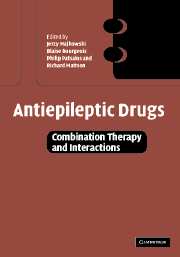Book contents
- Frontmatter
- Contents
- List of contributors
- Foreword
- Foreword
- Acknowledgements
- Part I Introduction
- Part II Pharmacokinetic interactions
- 4 Pharmacokinetic principles and mechanisms of drug interactions
- 5 Predictability of metabolic antiepileptic drug interactions
- 6 Influence of food and drugs on the bioavailability of antiepileptic drugs
- 7 Interactions between antiepileptic drugs
- 8 Interactions between antiepileptic and non-antiepileptic drugs
- Part III Pharmacodynamic interactions
- Part IV Drug interactions in specific patient populations and special conditions
- Part V Conclusions and future perspectives
- Index
5 - Predictability of metabolic antiepileptic drug interactions
from Part II - Pharmacokinetic interactions
Published online by Cambridge University Press: 07 September 2009
- Frontmatter
- Contents
- List of contributors
- Foreword
- Foreword
- Acknowledgements
- Part I Introduction
- Part II Pharmacokinetic interactions
- 4 Pharmacokinetic principles and mechanisms of drug interactions
- 5 Predictability of metabolic antiepileptic drug interactions
- 6 Influence of food and drugs on the bioavailability of antiepileptic drugs
- 7 Interactions between antiepileptic drugs
- 8 Interactions between antiepileptic and non-antiepileptic drugs
- Part III Pharmacodynamic interactions
- Part IV Drug interactions in specific patient populations and special conditions
- Part V Conclusions and future perspectives
- Index
Summary
Principles of drug metabolism
Many drugs are lipid soluble, weak organic acids or bases that are not readily eliminated from the body, being reabsorbed into the blood from the glomerular filtrate. Metabolic processes are necessary to convert a drug into one or more metabolites which are chemically different from the parent compound, but generally more polar and water soluble, facilitating their excretion in urine or bile. Although metabolism usually results in inactivation or detoxification, many drug metabolites have pharmacological activity. Metabolites may occasionally be much more active than the parent compound (which then may be designated as a prodrug), they may exert effects similar to or different from those of the parent molecule, or they may be responsible for toxic effects (Perucca and Richens, 1995). When metabolites are active, termination of their action occurs by further biotransformation or by direct excretion of the metabolite in urine or bile.
The chemical reactions involved in the biotransformation of drugs are catalyzed by various enzyme systems and are conventionally divided into phase I (functionalization) and phase II (conjugation) biotransformation reactions, which may occur in series. Phase I reactions involve the addition of a polar functional group (e.g. a hydroxyl group) or the deletion of a non-polar alkyl group (e.g. N-demethylation) by oxidation, reduction, or hydrolysis.
Keywords
- Type
- Chapter
- Information
- Antiepileptic DrugsCombination Therapy and Interactions, pp. 57 - 92Publisher: Cambridge University PressPrint publication year: 2005
- 7
- Cited by



